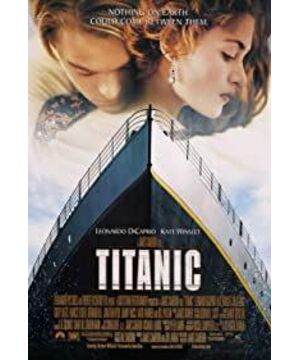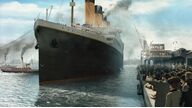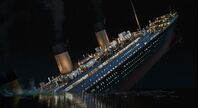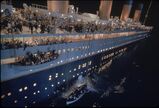The sinking of the Titanic was the most famous shipwreck in human history, and its social sensation was no less than the "9.11 Incident" in 2001. The reason for its huge impact is not only the number of people killed, but also because it was the largest, fastest, most sturdy, and most luxurious cruise ship that used the most advanced technology at that time. The "sinking" cruise ship suddenly "destroys the jade" in its landmark maiden voyage that has been highly publicized and people have paid great attention to. Its shocking degree can be imagined.
The Titanic ship name "Titanic" is divided into two parts "Titan/ic", "Titan" (Titan) is the incomparable giant who once ruled the world in Greek mythology, and "ic" is the suffix of the ship name standardized by the British White Star Line. . In 1908, Ismay, the chairman of White Star, decided to build three giant ships in order to compete with his rivals. The largest and most luxurious of them, the Titanic, began on March 31, 1909, and was completed on March 31, 1912. It is 270 meters long, 28 meters wide and has a displacement of 6. 60,000 tons, 50,000 horsepower thrust, and a speed of 25 knots. And its biggest selling point is safety and luxury: it has two bottoms and 16 watertight compartments, even if the four compartments are filled with water, it will not sink. Its luxurious decoration imitates the Palace of Versailles everywhere, especially the grand staircase in front of the first-class dining room is equipped with carved panels and gilded balustrades, topped by a glass dome, so that natural light floods the grand staircase, which is quite royal. Even the third-class cabin has a marble sink, which is comparable to the first-class cabin of an ordinary passenger ship. It is precisely because of its state-of-the-art equipment and design that it is generally regarded as an "unsinkable dream ship". The ship's board, from the chairman, the captain, to the crew, seems to have such "confidence". The film's description of this is very real: Ismay demands full speed ahead in order to grab the headlines of the newspaper, the captain ignores the warning of the iceberg, the lookout does not bring a telescope, and only observes with the naked eye. Ismay reduced the original design of 48 lifeboats to 20 in order to make the first-class deck spacious. The ship also did not conduct emergency training for the crew on the shipwreck. After the incident, some lifeboats that could hold 65 people only had a dozen people on board, which resulted in the death of more than 500 people. This false "confidence" finally led to a tragic tragedy. Of the 2,208 people on board, only 705 people survived and 1,503 people died (British and American reports vary). At that time, it was in the development period of industrial society, and the fruits of human conquest of nature continued to emerge. Some people thought that human beings were strong enough to defeat nature. And once the laws of nature are disregarded, nature will ruthlessly punish the impetuousness of human beings. This unprecedented shipwreck taught mankind a profound lesson and had a profound impact on the shipbuilding and shipping industry thereafter. Over the past 100 years, Europe and the United States have carried out a lot of exploration, research and reports on all aspects of this event. It has always been a hot spot of social concern and has become the topic of countless literary and artistic works. It has appeared on the screen more than ten times, the most famous before is the British film "Shipwreck on Ice" (1958), a documentary film that faithfully reproduces the passage of the shipwreck and the life and death of life. In addition to the Titanic, it also described the neighboring ships around it: a ship that was close at hand saw the Titanic cast fireworks and thought it was celebrating its maiden voyage; the telegraph operator of another passing ship turned off and went to sleep, Missed opportunity to save lives...
After decades of research, "Titanic science" seems to have been exhausted. September 1, 1985 became a watershed for this discipline: scientists found two wrecks of the Titanic bow and stern at the bottom of the North Atlantic Ocean, and found it again in 2005. its middle part. These discoveries once again set off a new wave of research on the Titanic, and people confirmed the true process of its sinking: after the bow sank into the sea, the stern lifted up, and under its heavy pressure, the hull broke into three pieces, and the stern fell again. On the water surface, due to the disconnection, the sinking bow dragged the stern into a vertical shape and submerged into the sea.
In the early 1990s, the adventurous Cameron also made many deep dives to visit the wreck of the Titanic. The new progress of CG (Computer Graphics) and Titanic has greatly stimulated his creative desire, and he felt that in addition to the clichés on this subject, he could also give full play to his own strengths and play new tricks. After careful thought, he decided to use the sinking of the Titanic as the background to interpret a tragic love story. He also ingeniously borrowed the famous "Diamond of Hope", and created a larger "Heart of the Ocean" cleverly interspersed with it. This drill not only makes the romantic romance more charming, but also convincingly integrates the two plots around 1984 and brings out the wreckage of the Titanic in a dramatic way. Spectacular contrast, highlighting the vicissitudes of history. Cameron's creative narrative angle breathes new life into this "old" subject and is one of the basic reasons for the film's success.
The love story is the most eye-catching, so the director takes it as the main plot line of the film, and the cause of the shipwreck is only a sub-line. However, this fictitious main line serves the real sub-line, so the setting of the characters, their personalities, and the conflict development of the plot are all developed around the needs of the sub-line. In the early 20th century, the hierarchical barriers of British and American society were still very strict, which was also very clear in the miniature world of Titanic. For example, the upper class people in the first class and the common people in the third class are separated in all aspects. This kind of confrontation between the rich and the poor, the director is critical, so he uses it as a dramatic conflict, and the love story he tells is Break through this barrier. Jack and Carl are two typical representatives of this rich and poor. The Rose family is a family in decline, struggling between rich and poor. Rose herself is a rebel of this hierarchy, and she challenges the stereotyped system with her actions, thus making the plot ups and downs. Of course, this is only a perspective. In fact, the heroine created by the director has a more detached outlook on life and values, and her personality is more colorful. She has artistic temperament and likes to paint. She became an actor after she escaped danger, and even made sculptures when she was a hundred years old. This is in sharp contrast to Karl, who is full of deals and stinks of copper, and also provides a footnote for her life-and-death love with Jack: she is not a willful girl, but has a clear life pursuit, and would rather wander around the world with Jack than with Carl lives the wealthy life of The Walking Dead. The 100-year-old Rose actually has a different understanding of life: she does not want to marry Carl, who has different tastes, and once wanted to commit suicide by jumping into the sea. She remembered Jack, because of his promise of "you jump and I jump!" This kind of life-and-death promise made her heart move. Twice she ran away from the lifeboat to follow Jack after she made a promise to him. Before Jack died, he asked her to promise to live for him, she promised, and so lived a hundred years. Lovett has been searching for the priceless "Heart of the Ocean" for three years, and diving deep into the ocean is ultimately impossible, but in her eyes, it is just an embellishment of her own painting. She has treasured this unsolicited diamond for decades, just because it is the only token that Jack has handled and remains around. Finally, when she came to Jack's burial place, she quietly threw it into the ocean again, may it be with her beloved. This value is obviously very different from Carl, Lovett and so on. At the end of the first version of the film, Lovett and Lissie saw old Rose walking towards the stern, thinking that she was going to jump into the sea, and hurriedly stopped her. They were very surprised when they found out that she was going to throw a diamond. Old Rose explained her emotional reasons and finally gained everyone's understanding. Comparing the two, the blank ending of the final version is obviously more charming.
Since the main line serves the secondary line, the two protagonists take the audience around the bow, stern, top bilge and bilge, so that they can browse the whole picture of the ship and avoid the audience being bored by the same background. The activities of the two also play the role of tandem, and at least one of him or her is "present" at key points in the shipwreck. If Rose found that there were not enough lifeboats, the designer told her that it could only hold half of the people; when the ship hit the iceberg, the two were almost hit; when the Titanic finally fell into the sea, they were on the scene at the stern. Since the audience usually identifies with the protagonist, such an arrangement makes the audience feel immersive through psychological empathy.
If the main line characters are purely fictional, then the key characters in the sub-line are real people, such as Ismay, Andrew, Smith, Murdoch and so on. Even first-class passenger Molly was a real person, and she became the poster child for survivors and was dubbed the "Unsinkable Molly Brown" by the media. However, the real Murdoch did not accept Carl's bribe as in the film, but instead did his duty to die and shipwreck. Relatives protested to the studio, and both Fox and Cameron apologized.
There are two points about the real scene of the sinking of the Titanic that the later generations sighed the most. This has even become a classic scene of the subject, and it is reflected in all related works, and this film is no exception. The first is the strict hierarchy. Not only are third-class passengers prohibited from entering the first-class area, but even when escaping from a sunken ship, they are strictly classified according to their ranks, so the difference in survival rate is nearly three times. Second, the principle of getting on the lifeboat is that women and children are given priority, so the last survivors are mostly women and children. During this time of life and death, most people behaved civilly, and there was only a boarding riot at the last moment of the sinking. In particular, the vast majority of the nearly 900 crew members were loyal to their duties and died on the job. Even some first-class rich people "see death as home". For example, in this film, a couple wears evening gowns, indicating that they want to walk like gentlemen; another pair of old people lie in a soaked bed hugging each other... It is especially admirable that A small band in all Titanic productions, they played throughout the sinking and faced death...
In addition to this soul-stirring love story, the biggest attraction of this film is the special effects, especially the CG special effects. Cameron first dived the ocean floor 12 times to film the wreck of the Titanic. Then, the Fox company bought 16 square kilometers of land on the coast of Mexico to build a photography studio, and blasted three large, medium and small pools. In the large pool, a Titanic model was made according to the original drawings in the original scale, and there are devices that can make it tilt and sink. In order to save money, only the filming area on the boat is decorated, and other parts are steel frames. In order to adapt to the local wind direction and to ensure that the smoke drifts back when shooting the "sailing" shot, the model is only built to starboard. In order to shoot the departure scene of the port side landing, all the props on the scene were reversed, and they were reversed during post-production. In the middle pool is built the luxurious interior of the first-class cabin that can be submerged in the water, such as the dining room and the grand staircase. The small pool is the scene after the sinking of the ship. In addition, a 20-meter-long model ship that can be broken in the middle was built. But these alone are not enough to reproduce the shipwreck process realistically. Cameron also used his best CG technology. The CG work is divided into 5 groups. The first group is responsible for camera tracking, providing motion control data for modeling, and ensuring that the action of the real scene and the virtual image matches. The second group made a virtual ocean. The third group made the 3D animation of the hull and was responsible for compositing with the model reality. The fourth group makes various objects outside the characters. The fifth group is responsible for the motion capture of actors' performances, and its data is used to create virtual characters. In the film's most classic stern sinking scene, the stern gradually tilted to 90 degrees, and hundreds of people screamed and slid into the sea from a height of nearly 100 meters. These vivid characters are CG characters. Another classic scene in the film is that after Jack "flyed" at the bow of the ship, the camera slowly pulled back to overlook the entire Titanic, and then flew over the hull, and the characters on the ship were vividly seen. The camera finally flew over the stern, watching the Titanic sail into the distance. The whole shot is done in one go, and the momentum is majestic. This famous shot is a CG special effect, which cost millions of dollars in just over ten seconds and was highly praised back then. With the rapid development of IT and Cameron's unremitting efforts, he produced "Avatar" in 2009, pushing CG special effects to a new level. Looking back at "Titanic" from today's perspective, its CG images are relatively rough, but it was indeed a rock-shattering milestone at the time.
It is worth mentioning that Cameron is indeed an all-rounder of art and technology. All the sketches of Jack in the film are from his handwriting, including the nude portrait of Rose. It is also his hand that paints and paints in the film.
The theme song "My Heart Is Still" is another highlight of the film. Cameron wanted to ask Irish singer Enya to compose and sing, but she declined. So I asked James Horner to write "My Heart Is Still" in the style of Enya, sung by Celine Dion. He was very satisfied after listening to it, so he used it as the curtain call. At this time, it is low-pitched, sometimes agitated, and the mournful and meaningful tune is extremely appropriate to express and vent the depressing emotions of the audience after watching the film. It is indeed a lingering sound, which is unforgettable.
Cameron is a perfectionist, with an extremely rigorous creative attitude and always strives for perfection. This kind of pursuit of perfection at all costs, the constant increase in expenditure and the repeated delays in the construction period made Fox intolerable. For fear of repeating the same mistakes of Lianmei's bankruptcy due to the loss of "Heaven's Gate", Fox threatened to stop paying 8 million yuan. Dollars for a director's fee, but Cameron would rather pay nothing to make the film perfect. After the film was released, it was loved by audiences all over the world, and many theaters continued to show it for several months. The $200 million, most expensive film eventually surpassed $1.8 billion in worldwide revenue, making it the highest-grossing film in movie history, a record that wasn't broken until Avatar was released. The unprecedented success of the film also made Fox disregard his previous suspicions and gave him $120 million in bonuses and bonuses.
Due to the success of "Avatar", the world film has been brought into the 3D era, Cameron decided to make the "Titanic" that haunted him in 3D as well. He announced that in April 2012, the 100th anniversary of the sinking of the Titanic, a 3D version of "Titanic" would be released. The film was not retaken, but the scene in the 3D film brought a new experience to the audience.
View more about Titanic reviews











